Early Childhood Learning Framework, NQS Homework Solution 2020
VerifiedAdded on 2023/06/18
|8
|2123
|168
Homework Assignment
AI Summary
This assignment solution addresses several questions related to the Early Childhood Learning Framework (EYLF) and the National Quality Standard (NQS) within the context of early childhood education. It covers topics such as supporting withdrawn children, facilitating learning about dinosaurs, and planning community excursions, all while aligning with specific outcomes from the EYLF. The solution also discusses the impact of the UN Convention on the Rights of the Child, the responsibilities of early childhood teachers and family day care coordinators, and the requirements of Quality Area 2 (Child Protection) and Quality Area 3 (Physical Environment) of the NQS. Furthermore, it outlines the assessment process for educational services as specified in the NQS and the requirements for notifying parents of policy changes, providing a comprehensive overview of key concepts and practices in early childhood education.
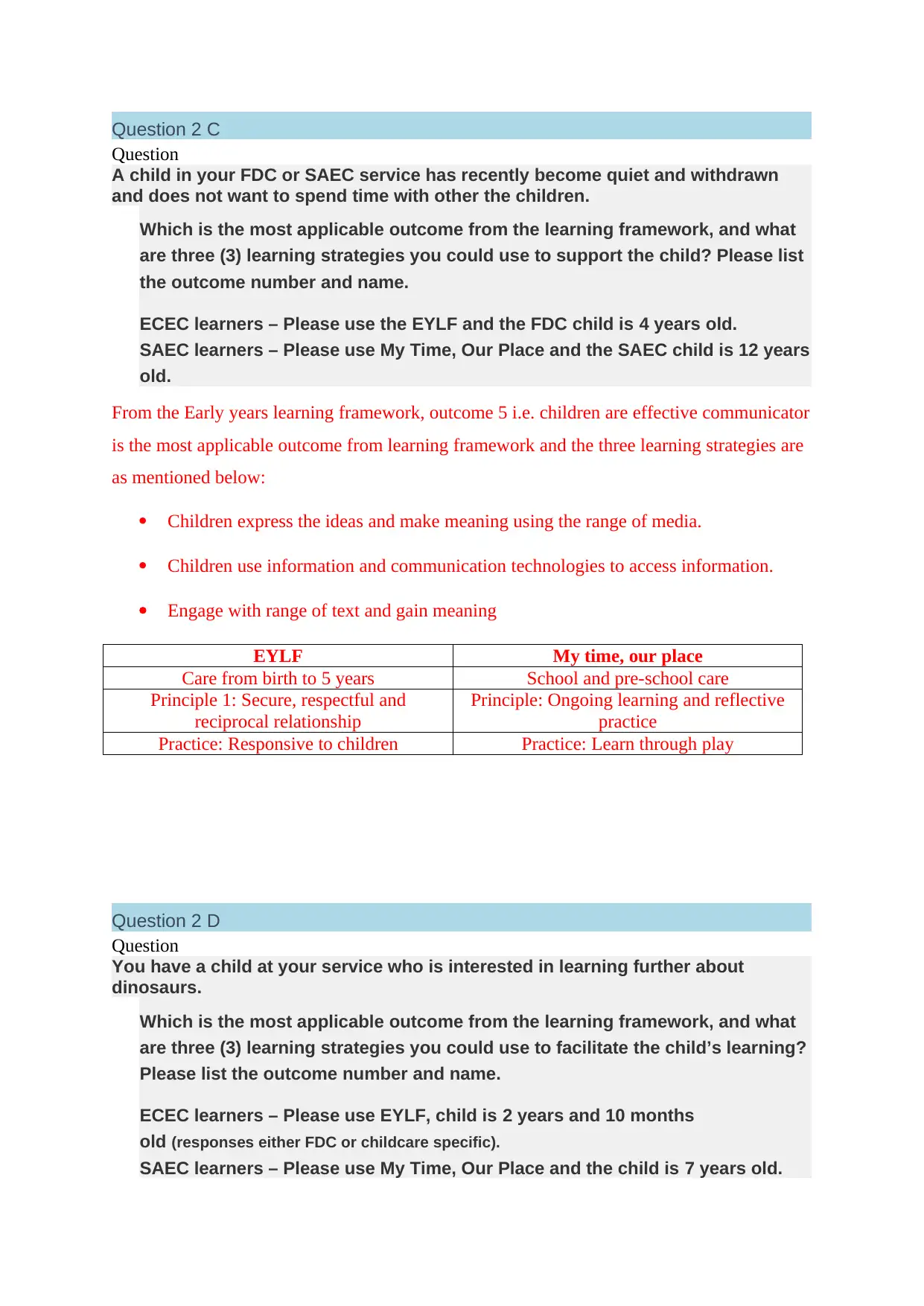
Question 2 C
Question
A child in your FDC or SAEC service has recently become quiet and withdrawn
and does not want to spend time with other the children.
Which is the most applicable outcome from the learning framework, and what
are three (3) learning strategies you could use to support the child? Please list
the outcome number and name.
ECEC learners – Please use the EYLF and the FDC child is 4 years old.
SAEC learners – Please use My Time, Our Place and the SAEC child is 12 years
old.
From the Early years learning framework, outcome 5 i.e. children are effective communicator
is the most applicable outcome from learning framework and the three learning strategies are
as mentioned below:
Children express the ideas and make meaning using the range of media.
Children use information and communication technologies to access information.
Engage with range of text and gain meaning
EYLF My time, our place
Care from birth to 5 years School and pre-school care
Principle 1: Secure, respectful and
reciprocal relationship
Principle: Ongoing learning and reflective
practice
Practice: Responsive to children Practice: Learn through play
Question 2 D
Question
You have a child at your service who is interested in learning further about
dinosaurs.
Which is the most applicable outcome from the learning framework, and what
are three (3) learning strategies you could use to facilitate the child’s learning?
Please list the outcome number and name.
ECEC learners – Please use EYLF, child is 2 years and 10 months
old (responses either FDC or childcare specific).
SAEC learners – Please use My Time, Our Place and the child is 7 years old.
Question
A child in your FDC or SAEC service has recently become quiet and withdrawn
and does not want to spend time with other the children.
Which is the most applicable outcome from the learning framework, and what
are three (3) learning strategies you could use to support the child? Please list
the outcome number and name.
ECEC learners – Please use the EYLF and the FDC child is 4 years old.
SAEC learners – Please use My Time, Our Place and the SAEC child is 12 years
old.
From the Early years learning framework, outcome 5 i.e. children are effective communicator
is the most applicable outcome from learning framework and the three learning strategies are
as mentioned below:
Children express the ideas and make meaning using the range of media.
Children use information and communication technologies to access information.
Engage with range of text and gain meaning
EYLF My time, our place
Care from birth to 5 years School and pre-school care
Principle 1: Secure, respectful and
reciprocal relationship
Principle: Ongoing learning and reflective
practice
Practice: Responsive to children Practice: Learn through play
Question 2 D
Question
You have a child at your service who is interested in learning further about
dinosaurs.
Which is the most applicable outcome from the learning framework, and what
are three (3) learning strategies you could use to facilitate the child’s learning?
Please list the outcome number and name.
ECEC learners – Please use EYLF, child is 2 years and 10 months
old (responses either FDC or childcare specific).
SAEC learners – Please use My Time, Our Place and the child is 7 years old.
Paraphrase This Document
Need a fresh take? Get an instant paraphrase of this document with our AI Paraphraser
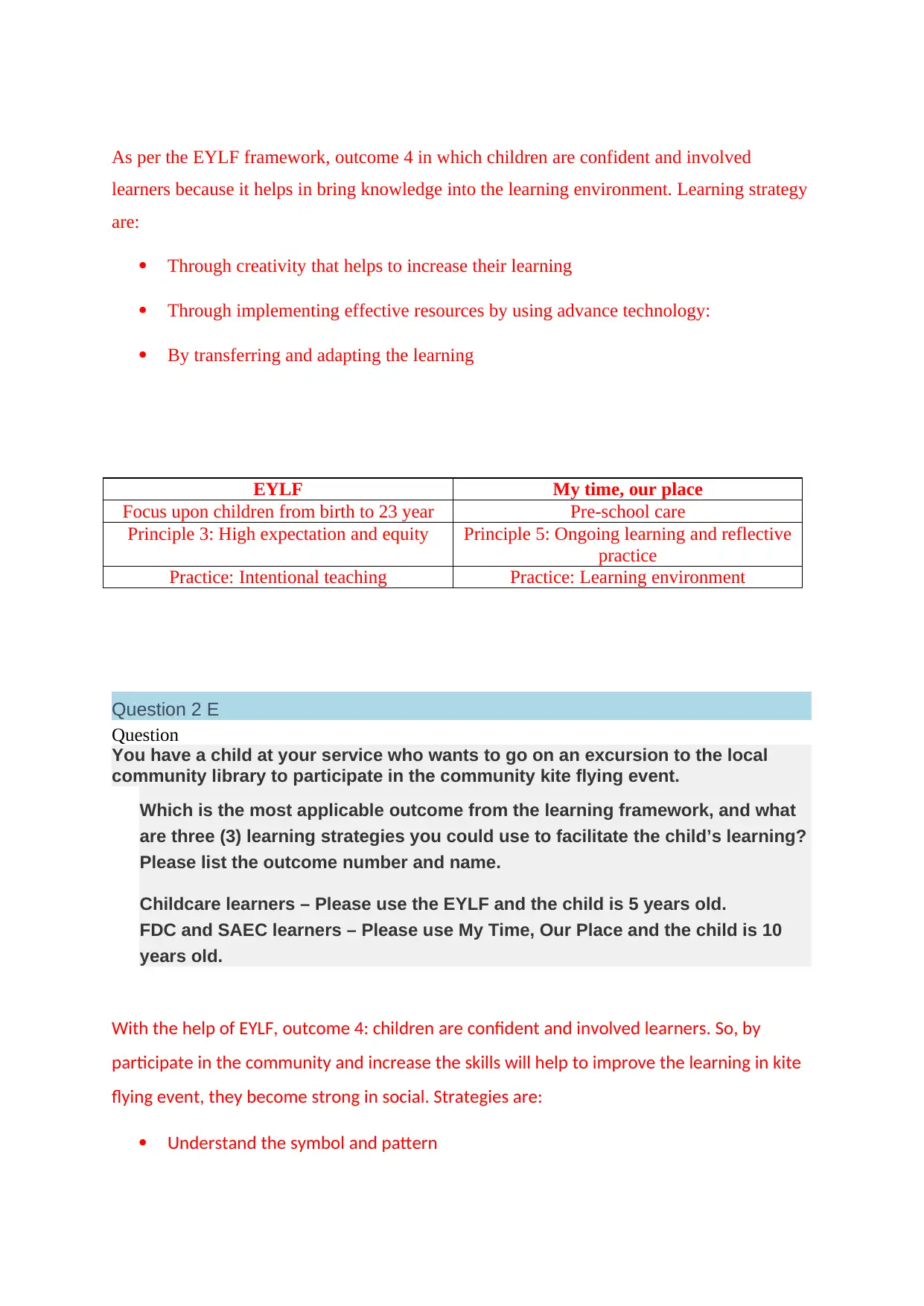
As per the EYLF framework, outcome 4 in which children are confident and involved
learners because it helps in bring knowledge into the learning environment. Learning strategy
are:
Through creativity that helps to increase their learning
Through implementing effective resources by using advance technology:
By transferring and adapting the learning
EYLF My time, our place
Focus upon children from birth to 23 year Pre-school care
Principle 3: High expectation and equity Principle 5: Ongoing learning and reflective
practice
Practice: Intentional teaching Practice: Learning environment
Question 2 E
Question
You have a child at your service who wants to go on an excursion to the local
community library to participate in the community kite flying event.
Which is the most applicable outcome from the learning framework, and what
are three (3) learning strategies you could use to facilitate the child’s learning?
Please list the outcome number and name.
Childcare learners – Please use the EYLF and the child is 5 years old.
FDC and SAEC learners – Please use My Time, Our Place and the child is 10
years old.
With the help of EYLF, outcome 4: children are confident and involved learners. So, by
participate in the community and increase the skills will help to improve the learning in kite
flying event, they become strong in social. Strategies are:
Understand the symbol and pattern
learners because it helps in bring knowledge into the learning environment. Learning strategy
are:
Through creativity that helps to increase their learning
Through implementing effective resources by using advance technology:
By transferring and adapting the learning
EYLF My time, our place
Focus upon children from birth to 23 year Pre-school care
Principle 3: High expectation and equity Principle 5: Ongoing learning and reflective
practice
Practice: Intentional teaching Practice: Learning environment
Question 2 E
Question
You have a child at your service who wants to go on an excursion to the local
community library to participate in the community kite flying event.
Which is the most applicable outcome from the learning framework, and what
are three (3) learning strategies you could use to facilitate the child’s learning?
Please list the outcome number and name.
Childcare learners – Please use the EYLF and the child is 5 years old.
FDC and SAEC learners – Please use My Time, Our Place and the child is 10
years old.
With the help of EYLF, outcome 4: children are confident and involved learners. So, by
participate in the community and increase the skills will help to improve the learning in kite
flying event, they become strong in social. Strategies are:
Understand the symbol and pattern
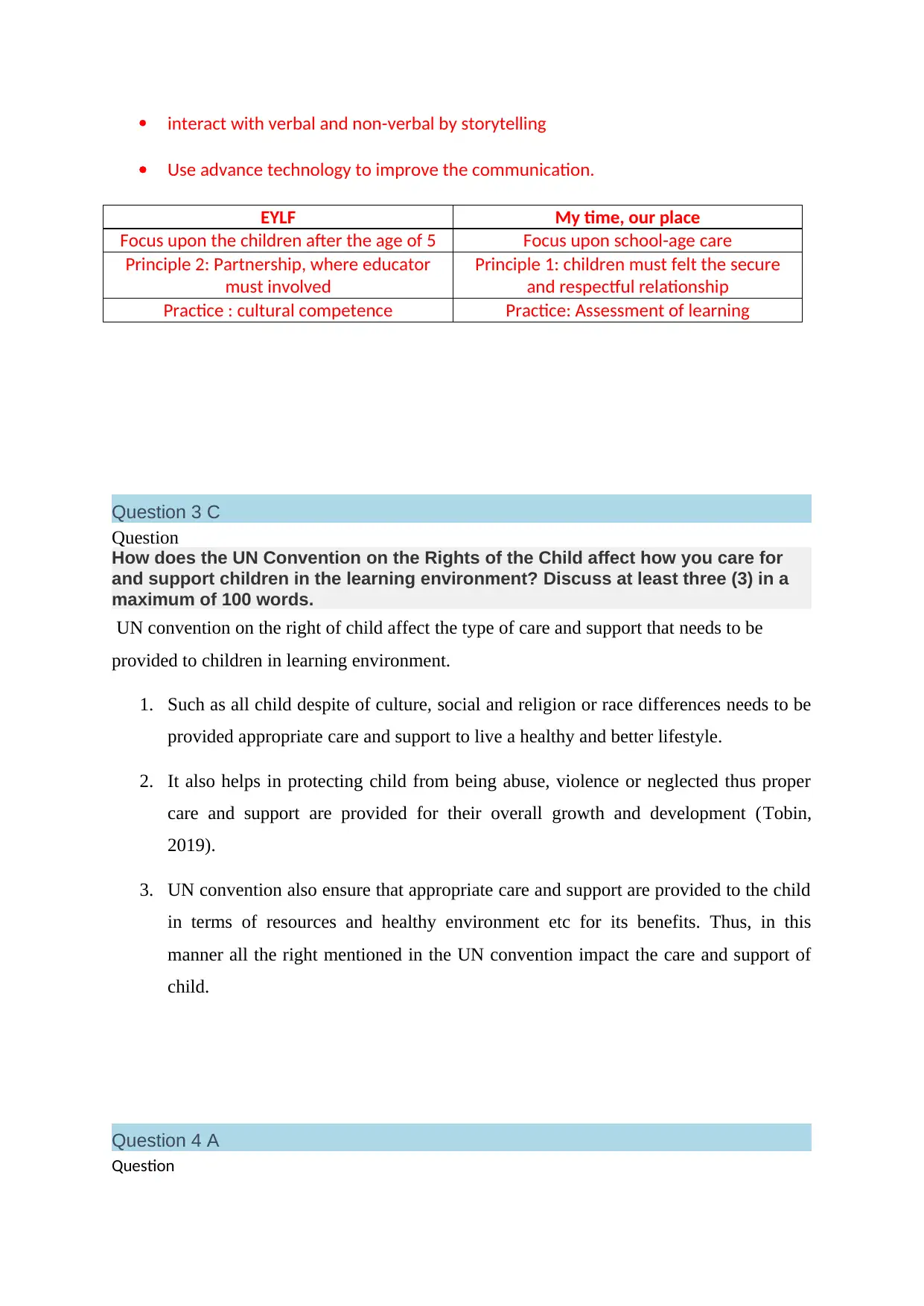
interact with verbal and non-verbal by storytelling
Use advance technology to improve the communication.
EYLF My time, our place
Focus upon the children after the age of 5 Focus upon school-age care
Principle 2: Partnership, where educator
must involved
Principle 1: children must felt the secure
and respectful relationship
Practice : cultural competence Practice: Assessment of learning
Question 3 C
Question
How does the UN Convention on the Rights of the Child affect how you care for
and support children in the learning environment? Discuss at least three (3) in a
maximum of 100 words.
UN convention on the right of child affect the type of care and support that needs to be
provided to children in learning environment.
1. Such as all child despite of culture, social and religion or race differences needs to be
provided appropriate care and support to live a healthy and better lifestyle.
2. It also helps in protecting child from being abuse, violence or neglected thus proper
care and support are provided for their overall growth and development (Tobin,
2019).
3. UN convention also ensure that appropriate care and support are provided to the child
in terms of resources and healthy environment etc for its benefits. Thus, in this
manner all the right mentioned in the UN convention impact the care and support of
child.
Question 4 A
Question
Use advance technology to improve the communication.
EYLF My time, our place
Focus upon the children after the age of 5 Focus upon school-age care
Principle 2: Partnership, where educator
must involved
Principle 1: children must felt the secure
and respectful relationship
Practice : cultural competence Practice: Assessment of learning
Question 3 C
Question
How does the UN Convention on the Rights of the Child affect how you care for
and support children in the learning environment? Discuss at least three (3) in a
maximum of 100 words.
UN convention on the right of child affect the type of care and support that needs to be
provided to children in learning environment.
1. Such as all child despite of culture, social and religion or race differences needs to be
provided appropriate care and support to live a healthy and better lifestyle.
2. It also helps in protecting child from being abuse, violence or neglected thus proper
care and support are provided for their overall growth and development (Tobin,
2019).
3. UN convention also ensure that appropriate care and support are provided to the child
in terms of resources and healthy environment etc for its benefits. Thus, in this
manner all the right mentioned in the UN convention impact the care and support of
child.
Question 4 A
Question
⊘ This is a preview!⊘
Do you want full access?
Subscribe today to unlock all pages.

Trusted by 1+ million students worldwide
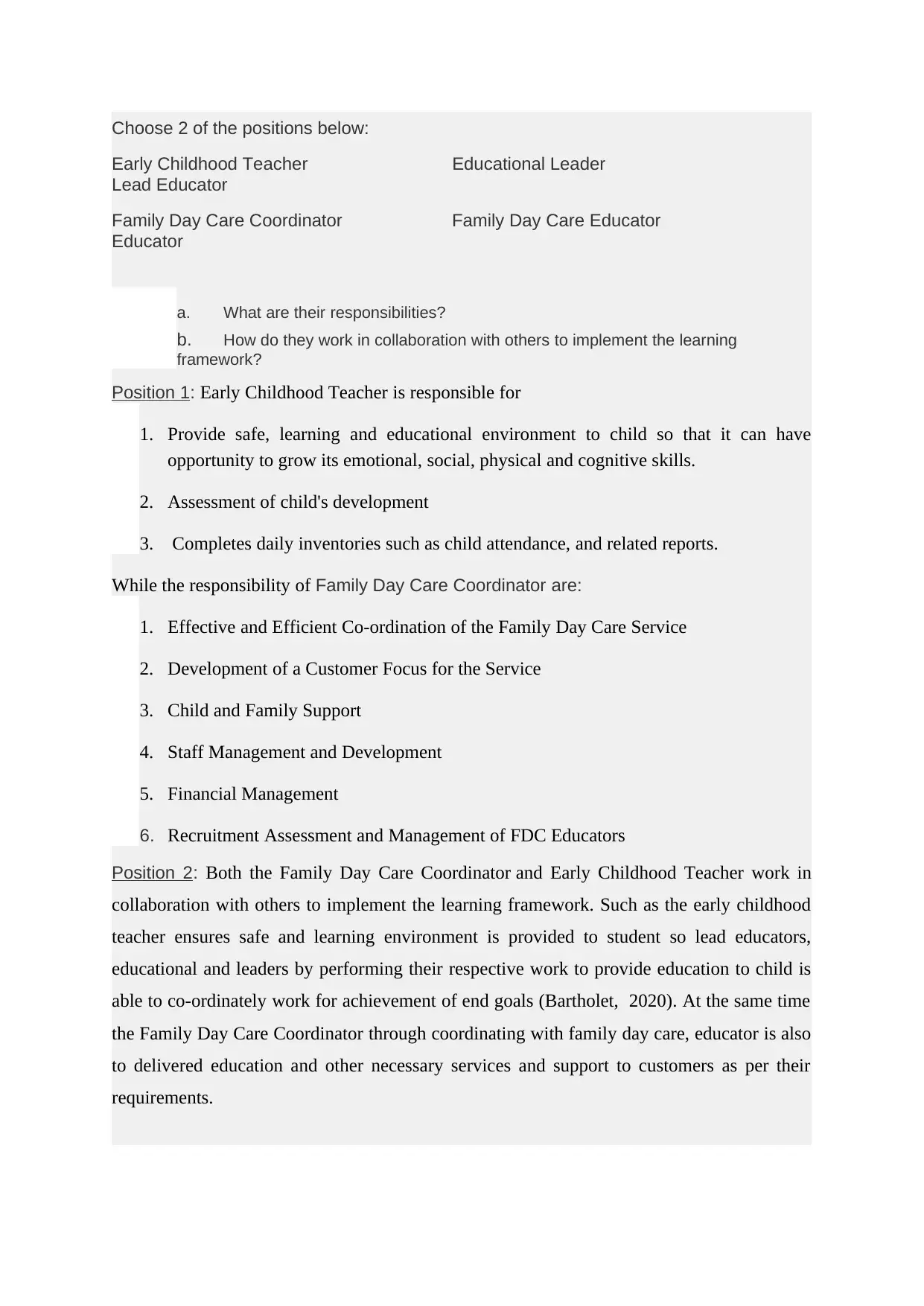
Choose 2 of the positions below:
Early Childhood Teacher Educational Leader
Lead Educator
Family Day Care Coordinator Family Day Care Educator
Educator
a. What are their responsibilities?
b. How do they work in collaboration with others to implement the learning
framework?
Position 1: Early Childhood Teacher is responsible for
1. Provide safe, learning and educational environment to child so that it can have
opportunity to grow its emotional, social, physical and cognitive skills.
2. Assessment of child's development
3. Completes daily inventories such as child attendance, and related reports.
While the responsibility of Family Day Care Coordinator are:
1. Effective and Efficient Co-ordination of the Family Day Care Service
2. Development of a Customer Focus for the Service
3. Child and Family Support
4. Staff Management and Development
5. Financial Management
6. Recruitment Assessment and Management of FDC Educators
Position 2: Both the Family Day Care Coordinator and Early Childhood Teacher work in
collaboration with others to implement the learning framework. Such as the early childhood
teacher ensures safe and learning environment is provided to student so lead educators,
educational and leaders by performing their respective work to provide education to child is
able to co-ordinately work for achievement of end goals (Bartholet, 2020). At the same time
the Family Day Care Coordinator through coordinating with family day care, educator is also
to delivered education and other necessary services and support to customers as per their
requirements.
Early Childhood Teacher Educational Leader
Lead Educator
Family Day Care Coordinator Family Day Care Educator
Educator
a. What are their responsibilities?
b. How do they work in collaboration with others to implement the learning
framework?
Position 1: Early Childhood Teacher is responsible for
1. Provide safe, learning and educational environment to child so that it can have
opportunity to grow its emotional, social, physical and cognitive skills.
2. Assessment of child's development
3. Completes daily inventories such as child attendance, and related reports.
While the responsibility of Family Day Care Coordinator are:
1. Effective and Efficient Co-ordination of the Family Day Care Service
2. Development of a Customer Focus for the Service
3. Child and Family Support
4. Staff Management and Development
5. Financial Management
6. Recruitment Assessment and Management of FDC Educators
Position 2: Both the Family Day Care Coordinator and Early Childhood Teacher work in
collaboration with others to implement the learning framework. Such as the early childhood
teacher ensures safe and learning environment is provided to student so lead educators,
educational and leaders by performing their respective work to provide education to child is
able to co-ordinately work for achievement of end goals (Bartholet, 2020). At the same time
the Family Day Care Coordinator through coordinating with family day care, educator is also
to delivered education and other necessary services and support to customers as per their
requirements.
Paraphrase This Document
Need a fresh take? Get an instant paraphrase of this document with our AI Paraphraser
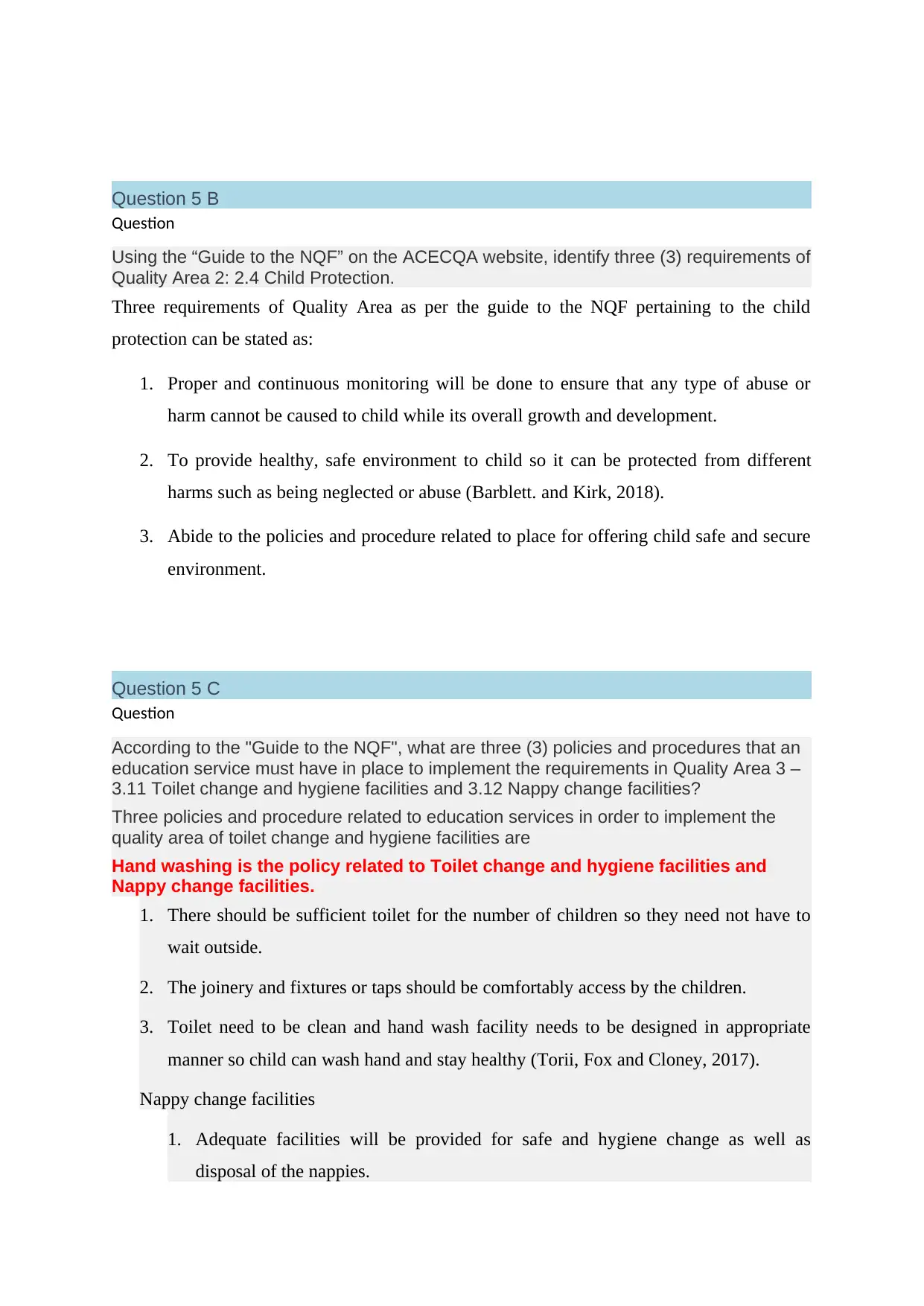
Question 5 B
Question
Using the “Guide to the NQF” on the ACECQA website, identify three (3) requirements of
Quality Area 2: 2.4 Child Protection.
Three requirements of Quality Area as per the guide to the NQF pertaining to the child
protection can be stated as:
1. Proper and continuous monitoring will be done to ensure that any type of abuse or
harm cannot be caused to child while its overall growth and development.
2. To provide healthy, safe environment to child so it can be protected from different
harms such as being neglected or abuse (Barblett. and Kirk, 2018).
3. Abide to the policies and procedure related to place for offering child safe and secure
environment.
Question 5 C
Question
According to the "Guide to the NQF", what are three (3) policies and procedures that an
education service must have in place to implement the requirements in Quality Area 3 –
3.11 Toilet change and hygiene facilities and 3.12 Nappy change facilities?
Three policies and procedure related to education services in order to implement the
quality area of toilet change and hygiene facilities are
Hand washing is the policy related to Toilet change and hygiene facilities and
Nappy change facilities.
1. There should be sufficient toilet for the number of children so they need not have to
wait outside.
2. The joinery and fixtures or taps should be comfortably access by the children.
3. Toilet need to be clean and hand wash facility needs to be designed in appropriate
manner so child can wash hand and stay healthy (Torii, Fox and Cloney, 2017).
Nappy change facilities
1. Adequate facilities will be provided for safe and hygiene change as well as
disposal of the nappies.
Question
Using the “Guide to the NQF” on the ACECQA website, identify three (3) requirements of
Quality Area 2: 2.4 Child Protection.
Three requirements of Quality Area as per the guide to the NQF pertaining to the child
protection can be stated as:
1. Proper and continuous monitoring will be done to ensure that any type of abuse or
harm cannot be caused to child while its overall growth and development.
2. To provide healthy, safe environment to child so it can be protected from different
harms such as being neglected or abuse (Barblett. and Kirk, 2018).
3. Abide to the policies and procedure related to place for offering child safe and secure
environment.
Question 5 C
Question
According to the "Guide to the NQF", what are three (3) policies and procedures that an
education service must have in place to implement the requirements in Quality Area 3 –
3.11 Toilet change and hygiene facilities and 3.12 Nappy change facilities?
Three policies and procedure related to education services in order to implement the
quality area of toilet change and hygiene facilities are
Hand washing is the policy related to Toilet change and hygiene facilities and
Nappy change facilities.
1. There should be sufficient toilet for the number of children so they need not have to
wait outside.
2. The joinery and fixtures or taps should be comfortably access by the children.
3. Toilet need to be clean and hand wash facility needs to be designed in appropriate
manner so child can wash hand and stay healthy (Torii, Fox and Cloney, 2017).
Nappy change facilities
1. Adequate facilities will be provided for safe and hygiene change as well as
disposal of the nappies.
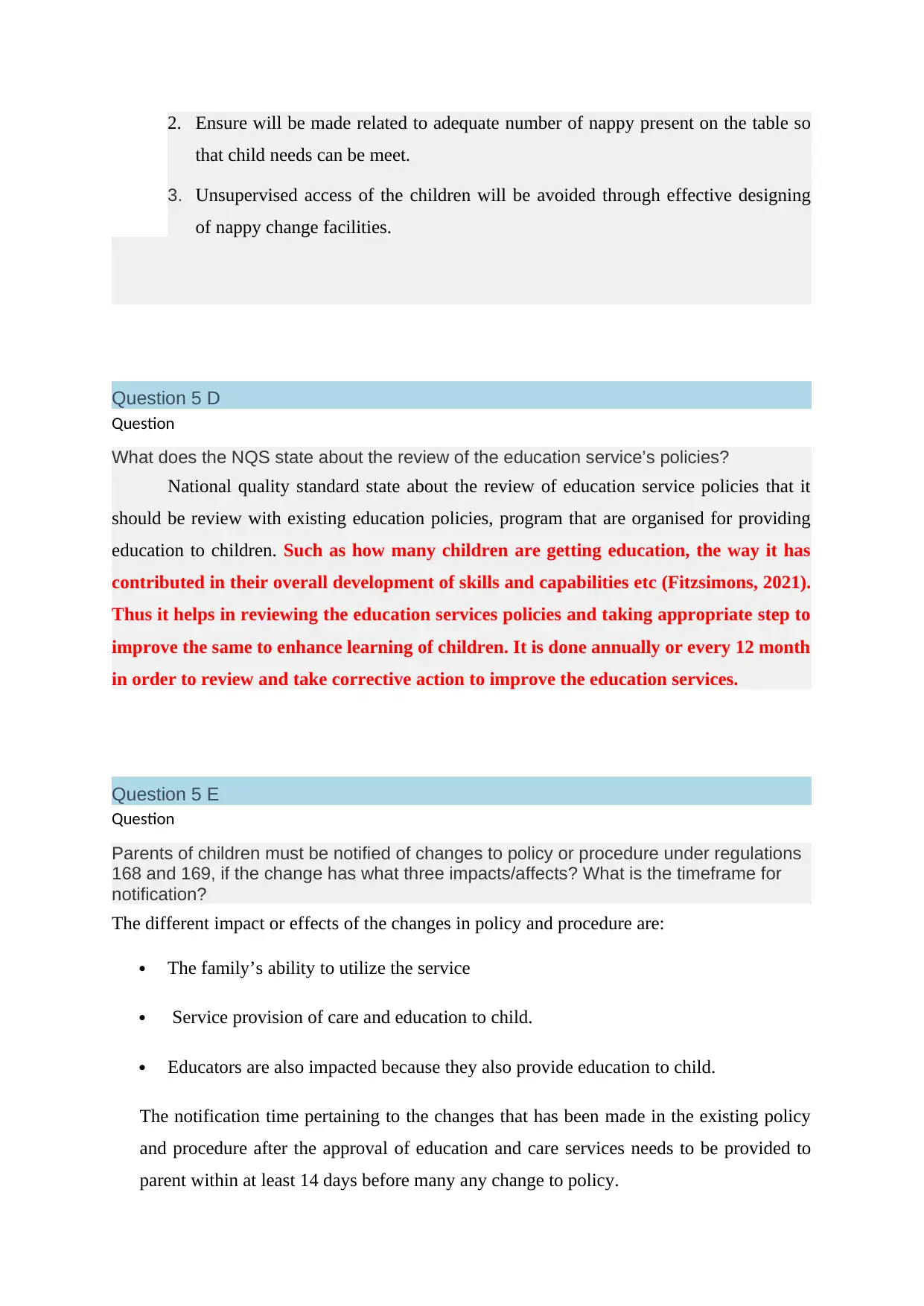
2. Ensure will be made related to adequate number of nappy present on the table so
that child needs can be meet.
3. Unsupervised access of the children will be avoided through effective designing
of nappy change facilities.
Question 5 D
Question
What does the NQS state about the review of the education service’s policies?
National quality standard state about the review of education service policies that it
should be review with existing education policies, program that are organised for providing
education to children. Such as how many children are getting education, the way it has
contributed in their overall development of skills and capabilities etc (Fitzsimons, 2021).
Thus it helps in reviewing the education services policies and taking appropriate step to
improve the same to enhance learning of children. It is done annually or every 12 month
in order to review and take corrective action to improve the education services.
Question 5 E
Question
Parents of children must be notified of changes to policy or procedure under regulations
168 and 169, if the change has what three impacts/affects? What is the timeframe for
notification?
The different impact or effects of the changes in policy and procedure are:
The family’s ability to utilize the service
Service provision of care and education to child.
Educators are also impacted because they also provide education to child.
The notification time pertaining to the changes that has been made in the existing policy
and procedure after the approval of education and care services needs to be provided to
parent within at least 14 days before many any change to policy.
that child needs can be meet.
3. Unsupervised access of the children will be avoided through effective designing
of nappy change facilities.
Question 5 D
Question
What does the NQS state about the review of the education service’s policies?
National quality standard state about the review of education service policies that it
should be review with existing education policies, program that are organised for providing
education to children. Such as how many children are getting education, the way it has
contributed in their overall development of skills and capabilities etc (Fitzsimons, 2021).
Thus it helps in reviewing the education services policies and taking appropriate step to
improve the same to enhance learning of children. It is done annually or every 12 month
in order to review and take corrective action to improve the education services.
Question 5 E
Question
Parents of children must be notified of changes to policy or procedure under regulations
168 and 169, if the change has what three impacts/affects? What is the timeframe for
notification?
The different impact or effects of the changes in policy and procedure are:
The family’s ability to utilize the service
Service provision of care and education to child.
Educators are also impacted because they also provide education to child.
The notification time pertaining to the changes that has been made in the existing policy
and procedure after the approval of education and care services needs to be provided to
parent within at least 14 days before many any change to policy.
⊘ This is a preview!⊘
Do you want full access?
Subscribe today to unlock all pages.

Trusted by 1+ million students worldwide
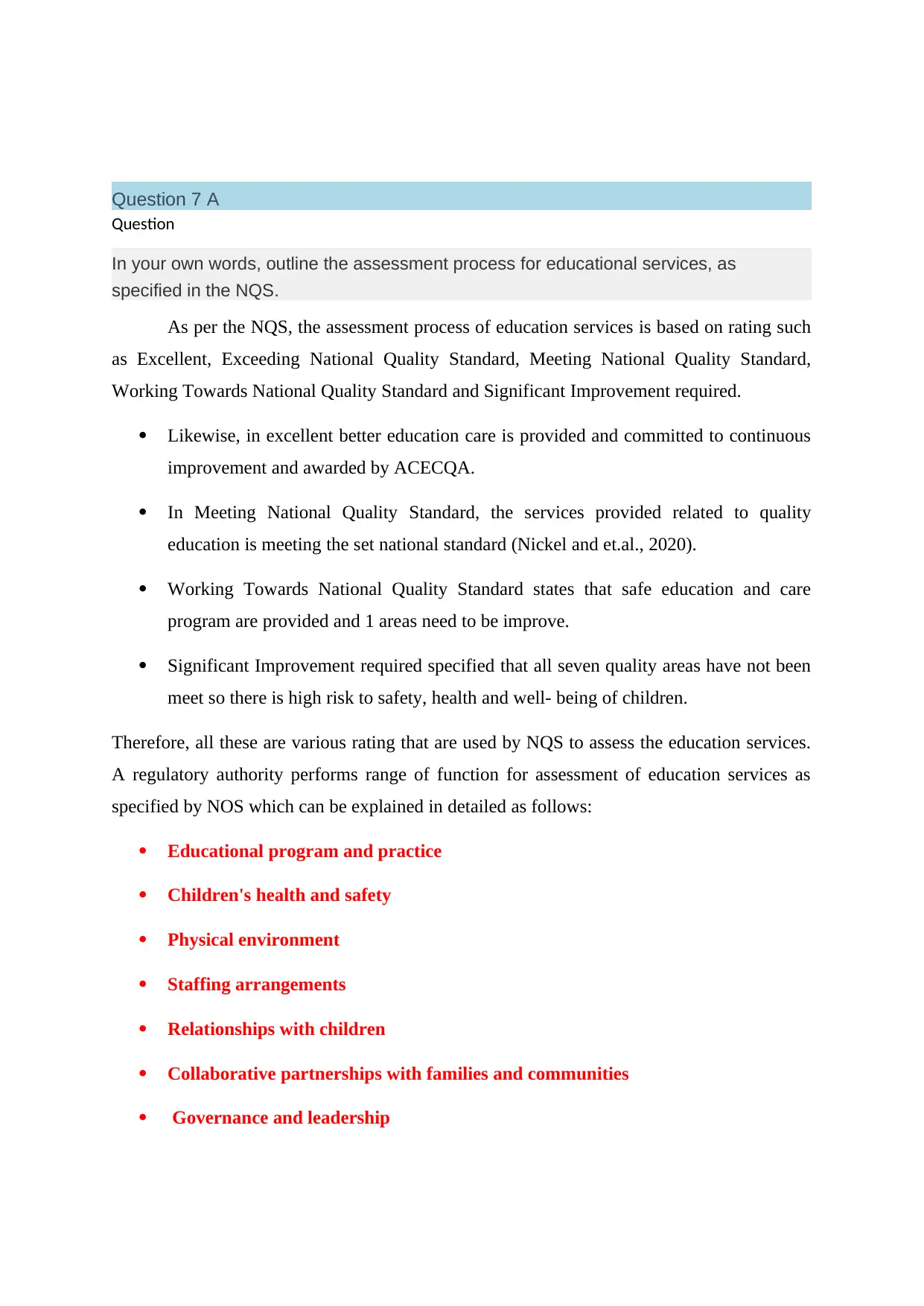
Question 7 A
Question
In your own words, outline the assessment process for educational services, as
specified in the NQS.
As per the NQS, the assessment process of education services is based on rating such
as Excellent, Exceeding National Quality Standard, Meeting National Quality Standard,
Working Towards National Quality Standard and Significant Improvement required.
Likewise, in excellent better education care is provided and committed to continuous
improvement and awarded by ACECQA.
In Meeting National Quality Standard, the services provided related to quality
education is meeting the set national standard (Nickel and et.al., 2020).
Working Towards National Quality Standard states that safe education and care
program are provided and 1 areas need to be improve.
Significant Improvement required specified that all seven quality areas have not been
meet so there is high risk to safety, health and well- being of children.
Therefore, all these are various rating that are used by NQS to assess the education services.
A regulatory authority performs range of function for assessment of education services as
specified by NOS which can be explained in detailed as follows:
Educational program and practice
Children's health and safety
Physical environment
Staffing arrangements
Relationships with children
Collaborative partnerships with families and communities
Governance and leadership
Question
In your own words, outline the assessment process for educational services, as
specified in the NQS.
As per the NQS, the assessment process of education services is based on rating such
as Excellent, Exceeding National Quality Standard, Meeting National Quality Standard,
Working Towards National Quality Standard and Significant Improvement required.
Likewise, in excellent better education care is provided and committed to continuous
improvement and awarded by ACECQA.
In Meeting National Quality Standard, the services provided related to quality
education is meeting the set national standard (Nickel and et.al., 2020).
Working Towards National Quality Standard states that safe education and care
program are provided and 1 areas need to be improve.
Significant Improvement required specified that all seven quality areas have not been
meet so there is high risk to safety, health and well- being of children.
Therefore, all these are various rating that are used by NQS to assess the education services.
A regulatory authority performs range of function for assessment of education services as
specified by NOS which can be explained in detailed as follows:
Educational program and practice
Children's health and safety
Physical environment
Staffing arrangements
Relationships with children
Collaborative partnerships with families and communities
Governance and leadership
Paraphrase This Document
Need a fresh take? Get an instant paraphrase of this document with our AI Paraphraser
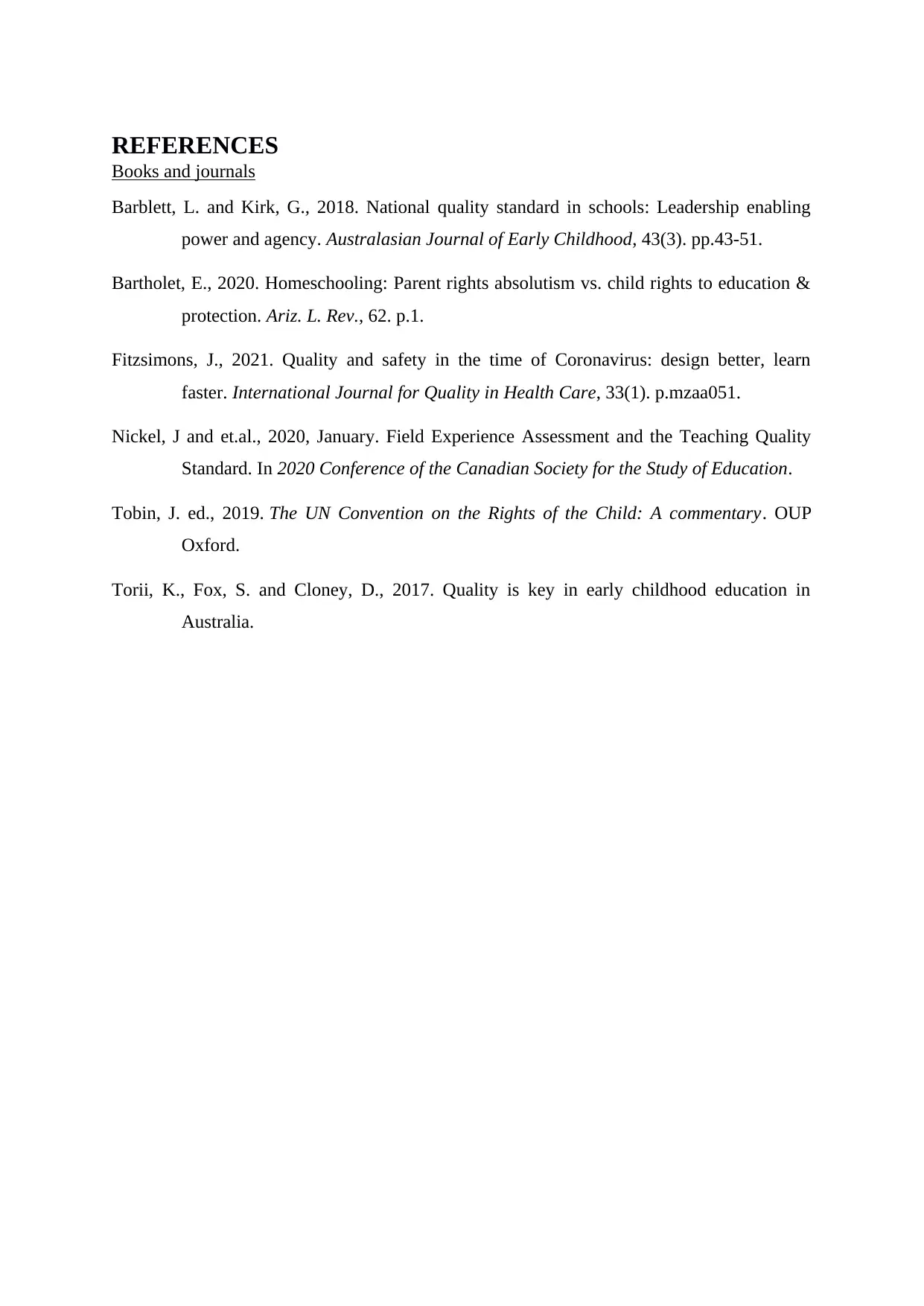
REFERENCES
Books and journals
Barblett, L. and Kirk, G., 2018. National quality standard in schools: Leadership enabling
power and agency. Australasian Journal of Early Childhood, 43(3). pp.43-51.
Bartholet, E., 2020. Homeschooling: Parent rights absolutism vs. child rights to education &
protection. Ariz. L. Rev., 62. p.1.
Fitzsimons, J., 2021. Quality and safety in the time of Coronavirus: design better, learn
faster. International Journal for Quality in Health Care, 33(1). p.mzaa051.
Nickel, J and et.al., 2020, January. Field Experience Assessment and the Teaching Quality
Standard. In 2020 Conference of the Canadian Society for the Study of Education.
Tobin, J. ed., 2019. The UN Convention on the Rights of the Child: A commentary. OUP
Oxford.
Torii, K., Fox, S. and Cloney, D., 2017. Quality is key in early childhood education in
Australia.
Books and journals
Barblett, L. and Kirk, G., 2018. National quality standard in schools: Leadership enabling
power and agency. Australasian Journal of Early Childhood, 43(3). pp.43-51.
Bartholet, E., 2020. Homeschooling: Parent rights absolutism vs. child rights to education &
protection. Ariz. L. Rev., 62. p.1.
Fitzsimons, J., 2021. Quality and safety in the time of Coronavirus: design better, learn
faster. International Journal for Quality in Health Care, 33(1). p.mzaa051.
Nickel, J and et.al., 2020, January. Field Experience Assessment and the Teaching Quality
Standard. In 2020 Conference of the Canadian Society for the Study of Education.
Tobin, J. ed., 2019. The UN Convention on the Rights of the Child: A commentary. OUP
Oxford.
Torii, K., Fox, S. and Cloney, D., 2017. Quality is key in early childhood education in
Australia.
1 out of 8
Related Documents
Your All-in-One AI-Powered Toolkit for Academic Success.
+13062052269
info@desklib.com
Available 24*7 on WhatsApp / Email
![[object Object]](/_next/static/media/star-bottom.7253800d.svg)
Unlock your academic potential
Copyright © 2020–2025 A2Z Services. All Rights Reserved. Developed and managed by ZUCOL.




